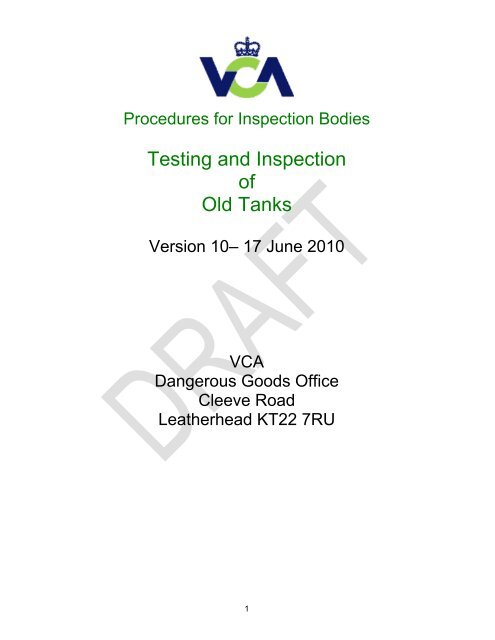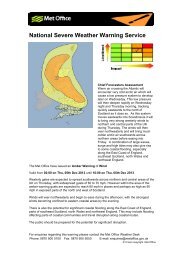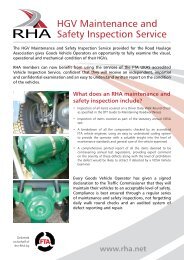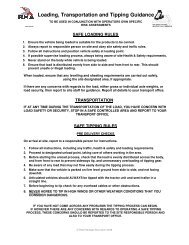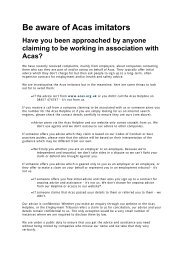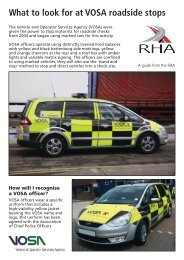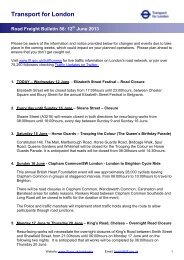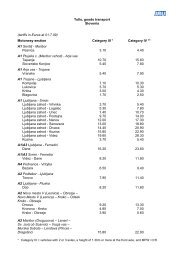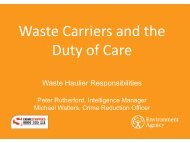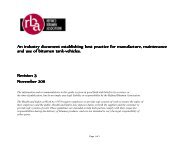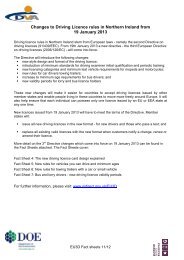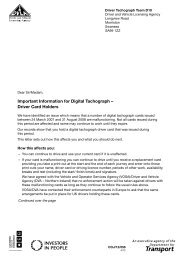Testing and Inspection of Old Tanks
Testing and Inspection of Old Tanks
Testing and Inspection of Old Tanks
Create successful ePaper yourself
Turn your PDF publications into a flip-book with our unique Google optimized e-Paper software.
Procedures for <strong>Inspection</strong> Bodies<strong>Testing</strong> <strong>and</strong> <strong>Inspection</strong><strong>of</strong><strong>Old</strong> <strong>Tanks</strong>Version 10– 17 June 2010VCADangerous Goods OfficeCleeve RoadLeatherhead KT22 7RU1
Contents1 Introduction................................................................................................................42 Background ...............................................................................................................53 Definitions <strong>and</strong> St<strong>and</strong>ards .........................................................................................6Table 1.......................................................................................................................6Table 2.......................................................................................................................7Sources: ....................................................................................................................74 Scope <strong>and</strong> Frequency ...............................................................................................8Table 3 Carriage by road...........................................................................................8Table 4 Carriage by rail.............................................................................................85 Tank record <strong>and</strong> Certificates .....................................................................................9Type Certificate .........................................................................................................96 <strong>Inspection</strong> Requirements ........................................................................................10Table 5.....................................................................................................................10Exceptional checks..................................................................................................12Table 7.....................................................................................................................127 Tank <strong>Inspection</strong> Procedures ...................................................................................137.1 General....................................................................................................................137.2 Check <strong>of</strong> the design characteristics ........................................................................13<strong>Inspection</strong> <strong>of</strong> the materials <strong>and</strong> wall thicknesses....................................................13Examination <strong>of</strong> the manufacturing methods............................................................13<strong>Inspection</strong> <strong>of</strong> the condition <strong>of</strong> the tank ....................................................................13<strong>Inspection</strong> <strong>of</strong> main dimensions................................................................................14Non-destructive testing <strong>of</strong> the welds .......................................................................14Table 8.....................................................................................................................15[7.3 <strong>Testing</strong> <strong>of</strong> test plates] ..............................................................................................157.4 <strong>Inspection</strong> <strong>of</strong> the tank interior ..................................................................................15<strong>Inspection</strong> <strong>of</strong> protective lining or coating.................................................................167.5 <strong>Inspection</strong> <strong>of</strong> the tank exterior .................................................................................16<strong>Inspection</strong> <strong>of</strong> the condition <strong>of</strong> the tank ....................................................................16<strong>Inspection</strong> <strong>of</strong> the fastenings <strong>of</strong> the tank <strong>and</strong> its structural equipment.....................17<strong>Inspection</strong> <strong>of</strong> marking ..............................................................................................17<strong>Inspection</strong> <strong>of</strong> earthing terminal ................................................................................177.6 Hydraulic pressure test including alternative methods ...........................................17General....................................................................................................................17Extent <strong>of</strong> test ...........................................................................................................18Test pressure ..........................................................................................................18Alternatives to hydraulic testing ..............................................................................20Table 9 - St<strong>and</strong>ards for NDT ...................................................................................207.7 Vacuum testing........................................................................................................21Test procedure ........................................................................................................217.8 Leakpro<strong>of</strong>ness test ..................................................................................................21General....................................................................................................................21Extent <strong>of</strong> test ...........................................................................................................21Leakpro<strong>of</strong>ness test pressure...................................................................................222
Leakpro<strong>of</strong>ness test fluid ..........................................................................................22Pressurisation..........................................................................................................22Test duration ...........................................................................................................22Evaluation <strong>of</strong> the test...............................................................................................237.9 Determination <strong>of</strong> capacity........................................................................................23General....................................................................................................................237.10 <strong>Inspection</strong> <strong>of</strong> service equipment.............................................................................23<strong>Inspection</strong> <strong>of</strong> service equipment for the tank ..........................................................23<strong>Inspection</strong> <strong>of</strong> service equipment for other inspections............................................23<strong>Inspection</strong> <strong>of</strong> correct functioning <strong>of</strong> service equipment...........................................247.11 <strong>Inspection</strong> <strong>of</strong> the frame or other structural equipment <strong>of</strong> portable tanks <strong>and</strong> tankcontainers................................................................................................................24<strong>Inspection</strong> <strong>of</strong> frame or other structural equipment ..................................................24Initial, periodic, intermediate inspection <strong>and</strong> exceptional check <strong>of</strong> the frame orother structural equipment <strong>of</strong> portable tanks <strong>and</strong> tank containers..........................247.12 Failure at inspection ...............................................................................................257.13 Test report, certification <strong>and</strong> marking.....................................................................25Certification <strong>of</strong> periodic, intermediate inspection <strong>and</strong> exceptional check ...............25Marking....................................................................................................................25Annex A - Provisions for particular tank types ...................................................................26Annex B - Petroleum Road Tanker ....................................................................................27INTERMEDIATE INSPECTION ..............................................................................27Examination <strong>of</strong> Documents. ....................................................................................27PERIODIC INSPECTION........................................................................................28CERTIFICATION AND MARKING ..........................................................................28Annex C - General Chemical Road Tanker .......................................................................29INTERMEDIATE INSPECTION ..............................................................................29PERIODIC INSPECTION 6 YEARS........................................................................30CERTIFICATION AND MARKING ..........................................................................30Annex D - General Chemical Tank Container ...................................................................31INTERMEDIATE INSPECTION ..............................................................................31CERTIFICATION AND MARKING ..........................................................................33Annex E - Vacuum Waste Tanker......................................................................................34INTERMEDIATE INSPECTION ..............................................................................34ANNEX F............................................................................................................................373
1 IntroductionThe Carriage <strong>of</strong> Dangerous Goods <strong>and</strong> Use <strong>of</strong> Transportable Pressure EquipmentRegulations 2009 (CDG 2009) bring Directive 2008/68/EC on the inl<strong>and</strong> transport <strong>of</strong>dangerous goods (DG Directive) into effect in GB. The DG Directive brings together therequirements for the rail <strong>and</strong> road transport <strong>and</strong> adds requirements for inl<strong>and</strong> waterways.The DG Directive requires tanks to comply with provisions <strong>of</strong> RID <strong>and</strong> ADR for bothconstruction <strong>and</strong> for use. The DG Directive permits tanks constructed to nationalrequirements <strong>and</strong> not to the provisions <strong>of</strong> RID or ADR. These tanks known as ‘old tanks’in GB <strong>and</strong> NI, are restricted to national transport unless there is agreement betweenindividual states to allow cross border traffic. <strong>Old</strong> tanks may continue in service, providedthey are properly maintained <strong>and</strong> are safe for the remainder <strong>of</strong> their working lives.<strong>Tanks</strong> for the carriage <strong>of</strong> dangerous goods in GB <strong>and</strong> NI that were not RID or ADR tankswere inspected by a ‘competent person’ to a ‘written scheme <strong>of</strong> examination’. Thismethod <strong>of</strong> examining tanks does not require the competent person to be appointed <strong>and</strong>the owner/ operator <strong>of</strong> the tank has the responsibility to write a suitable written scheme<strong>of</strong> examination <strong>and</strong> to ensure that it is carried out. On 2 July 2006 inspections bycompetent persons ended with inspections now being carried out by inspection bodiesappointed by the Secretary <strong>of</strong> State for Transport.These procedures replace the individual written schemes <strong>of</strong> examination with anapproach based upon the requirements <strong>of</strong> RID <strong>and</strong> ADR but taking account <strong>of</strong> thedifferent constructional differences that may exist between old tanks <strong>and</strong> RID or ADRtanks. The requirement for old tanks to be maintained to a written scheme <strong>of</strong>examination is set out in the Carriage <strong>of</strong> Dangerous Goods; Approved Derogations <strong>and</strong>Transitional Provisions (Approved Derogations). These procedures <strong>and</strong> must be used<strong>and</strong> applied in accordance with the Approved Derogations including any transitionalprovision in the Approve Derogations.The competent authority for the appointment <strong>of</strong> tank <strong>and</strong> pressure receptacle inspectionbodies is in GB, the Secretary <strong>of</strong> State for Transport <strong>and</strong> HSENI in Northern Irel<strong>and</strong>.Compliance with these procedures is necessary for appointment <strong>and</strong> continuation <strong>of</strong>appointment as an inspection body. These procedures cannot cover all situations <strong>and</strong>will be amended in the light <strong>of</strong> experience <strong>and</strong> changes in legislation.That success in the inspections <strong>and</strong> tests conducted in accordance with theseprocedures, <strong>and</strong> the allocation <strong>of</strong> a certificate does not authorise the use <strong>of</strong> a tank forany dangerous goods. The tank instructions, published in the various modal regulationsmust also be complied with as must all other relevant requirements <strong>of</strong> the modalregulations.4
2 BackgroundThe UN Recommendations on the Transport <strong>of</strong> Dangerous Goods (Model Regulations)have been developed by the United Nations Committee <strong>of</strong> Experts on the Transport <strong>of</strong>Dangerous Goods <strong>and</strong> the Globally Harmonised system <strong>of</strong> Classification <strong>and</strong> Labelling<strong>of</strong> Chemicals. The Model Regulations continue to be developed in the light <strong>of</strong> technicalprogress, the advent <strong>of</strong> new substances <strong>and</strong> materials, the exigencies <strong>of</strong> moderntransport systems <strong>and</strong> above all the need to ensure the safety <strong>of</strong> people, property <strong>and</strong>the environment. Amongst other aspects, the Model Regulations list the principaldangerous goods, define methods for classification, set out general packing, marking,labelling, placarding requirements, testing procedures, <strong>and</strong> specify shippingdocumentation. There are in addition special recommendations related to particularclasses <strong>of</strong> goods.The Model Regulations are given legal entity by the provisions <strong>of</strong> a series <strong>of</strong> internationalmodal agreements <strong>and</strong> national legislation for the transport <strong>of</strong> dangerous goods. Theinternational agreements include:The European Agreement Concerning the International Carriage <strong>of</strong> DangerousGoods by Road (ADR) (covering most <strong>of</strong> Europe)Regulations concerning the International Carriage <strong>of</strong> Dangerous Goods by Rail(RID) (covering most <strong>of</strong> Europe, parts <strong>of</strong> North Africa <strong>and</strong> the Middle East)The International Maritime Dangerous Goods Code (IMDG Code) (worldwide)The International Civil Aviation Organization’s Technical Instructions for the SafeTransport <strong>of</strong> Dangerous Goods by Air (ICAO TIs) (worldwide).In each country transporting dangerous goods, a ‘competent authority’ is responsible forimplementing the regulations. Amongst other things, the competent authority may set upa system for testing <strong>and</strong> certifying pressure receptacles, tanks <strong>and</strong> packagings to meetthe requirements <strong>of</strong> those regulations.The background described above sets the context in which this document should beseen. For the purposes <strong>of</strong> old tank inspections the international regulations are notgenerally relevant although the principles adopted in ADR <strong>and</strong> RID are being usedwherever possible in this document. For the purposes <strong>of</strong> using (operating) the tank theprovisions above are applicable.5
3 Definitions <strong>and</strong> St<strong>and</strong>ardsThe terms <strong>and</strong> definitions used in this document are taken as those given by the relevantregulations concerning the transport <strong>of</strong> dangerous goods unless otherwise stated inTable 1 below.Table 1TermTank recordInspector<strong>Inspection</strong> bodyIntermediateinspection<strong>Old</strong> tankProtective liningDefinitionMeans a file containing all the important technical informationsuch as the original design documentation, previousinspection reports <strong>and</strong> records <strong>of</strong> repairs (NOTE: see 5.2).means individual employed by <strong>and</strong> carrying out inspectionsfor an inspection body.is a generic term for a body appointed by the competentauthority to perform designated inspections <strong>and</strong> tests.means inspection carried out between the initial <strong>and</strong> the firstperiodic inspection or between two periodic inspectionsis a tank as defined in the “Carriage <strong>of</strong> Dangerous GoodsApproved Derogations <strong>and</strong> Transitional provisions”or coating means a lining or coating protecting the metallictank material against the corrosive attack by the substancesto be carriedNOTE: This does not apply to lining or coating used only toprotect the substance to be carried.Major repair:Technical codeA repair without which the safety <strong>of</strong> the tank or structurewould have been compromised. This will include any repairthat requires hotwork to the pressure containment part <strong>of</strong> thetankmeans the code according to which the tank has beendesigned <strong>and</strong> constructed6
The st<strong>and</strong>ards <strong>and</strong> guidance listed in Table 2 below are indispensable for the application<strong>of</strong> this document. For dated references, only the edition cited applies. For undatedreferences, the latest edition <strong>of</strong> the referenced document (including any amendments)applies.Table 2St<strong>and</strong>ardEN 473EN 837–2EN 1432: 1997EN1435Title IdentifierNon-destructive testing - Qualification <strong>and</strong> certification <strong>of</strong>NDT personnel – General principlesPressure gauges Selection <strong>and</strong> installationrecommendations for pressure gaugesSwap bodies. Swap tanks. Dimensions, requirements, testmethods, operating conditionsNon-destructive examination <strong>of</strong> welds. Radiographicexamination <strong>of</strong> welded jointsISO 1496: 1995 Series 1 freight containers – Specification <strong>and</strong> testing –Part 3: Tank containers for liquids, gases <strong>and</strong> pressuriseddry bulkEN1714EN 12266–1:2003EN 12972:2007EN 14025GS4 HSENon-destructive testing <strong>of</strong> welded joints. Ultrasonic testing<strong>of</strong> welded jointsIndustrial valves – <strong>Testing</strong> <strong>of</strong> valves – Part 1: Pressuretests, test procedures <strong>and</strong> acceptance criteria – M<strong>and</strong>atoryrequirements<strong>Tanks</strong> for the transport <strong>of</strong> dangerous goods – <strong>Testing</strong>,inspection <strong>and</strong> marking <strong>of</strong> metallic tanks<strong>Tanks</strong> for transport <strong>of</strong> dangerous goods. Metallic pressuretanks. Design <strong>and</strong> constructionSafety in Pressure <strong>Testing</strong>, which is supported by ContractResearch Report CRR168: "Pressure Test Safety", 1998(ISBN 9780717616299)Sources:BS, EN ISO St<strong>and</strong>ards are obtainable from the British St<strong>and</strong>ards Institutionhttp://www.st<strong>and</strong>ardsuk.com/HSE publications are obtainable from HSE Books:http://books.hse.gov.uk/hse/public/home.jsf7
4 Scope <strong>and</strong> FrequencyThese procedures specify the testing, inspection <strong>and</strong> marking for the periodic inspection,intermediate inspection <strong>and</strong> exceptional check <strong>of</strong> old metallic tanks (shell <strong>and</strong>equipment) that are fixed tanks (tank vehicles), demountable tanks, rail tank wagons,portable tanks <strong>and</strong> tank containers for the transport <strong>of</strong> dangerous goodsThese procedures are not applicable to: pressure receptacles including gas cylinders orintermediate bulk containers (IBCs).The intervals between inspections shall not exceed those shown in Table 3 <strong>and</strong> table 4below.Table 3 Carriage by roadTankFixed tanks (tank vehicles), demountable tanks <strong>and</strong>battery-vehiclesIntermediate Periodic3 years 6 years<strong>Tanks</strong> carrying refrigerated liquefied gases except chlorine 6 years 6 years<strong>Tanks</strong> carrying chlorine N/A 3 yearsTable 4 Carriage by railTankIntermediate Periodicfixed tanks, demountable tanks <strong>and</strong> battery-/ wagons 4 years 8 yearstanks carrying refrigerated liquefied gases except chlorine 6 years 8 yearstanks carrying chlorine N/A 3 years8
5 Tank record <strong>and</strong> Certificates5.1 RecordsFor old tanks there may be incomplete records or no records at all. For tank-vehiclesdemountable tanks <strong>and</strong> battery-vehicles [wagons] the record shall start at the latest withthe first inspection carried out on or after 2 July 2006.Where no records exists an <strong>Inspection</strong> Body at the first inspection <strong>of</strong> the tank under thisprocedure shall carry out a full specification check as far as reasonably practical <strong>and</strong> itshall include:• Dimensions• Capacity• Tank thickness• Service equipmentNote:The tank record including the inspection files should be available for the life <strong>of</strong> thetank. On transfer <strong>of</strong> ownership, the tank records must be transferred to new owner. Atthe end <strong>of</strong> the tanks working life the owner, disposing <strong>of</strong> the tank must retain the tankrecords for at least 15 months.Owners /Operators <strong>of</strong> tanks should maintain a file <strong>of</strong> inspection records <strong>and</strong> include ahistory <strong>of</strong> at least 6 years for road tanks <strong>and</strong> 8 years for rail tanks, where the tank is atleast 6/8 years old.If the original design specifications including technical codes are available, theyshould form part <strong>of</strong> a tank record5.2 Type CertificateAlthough type approval certificates may not exist for old tanks, the owner / operatorshould have a record <strong>of</strong> previous inspections <strong>and</strong> <strong>of</strong> the original approval documentationfrom the time <strong>of</strong> purchase <strong>and</strong> these shall be used by the inspection body to completerecords. The use <strong>of</strong> electronic records is acceptable provided access is readily available.9
6 <strong>Inspection</strong> Requirements6.1 The periodic, intermediate inspection or exceptional check shall be carried out inaccordance with the relevant sections <strong>of</strong> these Procedures as set in Table 5 below <strong>and</strong>for exceptional checks only, Table 6.Table 5Relevant sectionsPeriodic<strong>Inspection</strong>Intermediate<strong>Inspection</strong>ExceptionalCheckSee alsotable 6Section 5 - Examination <strong>of</strong>documentsx x xSection 7.2 - Check <strong>of</strong> designcharacteristics following repair ormodificationSection 7.4 - <strong>Inspection</strong> <strong>of</strong> the tankinteriorx x xSection 7.5 - <strong>Inspection</strong> <strong>of</strong> the tankexteriorx x xSection 7.6Hydraulic - pressuretestxxSection 7.8 - Leakpro<strong>of</strong>ness test x x xSection 7.10 - <strong>Inspection</strong> <strong>of</strong>service equipmentx x xSection 7.11 - <strong>Inspection</strong> <strong>of</strong> theframe or other structuralequipment <strong>of</strong> portable tanks <strong>and</strong>tank containers where required byregulationx x x10
6.2 For vacuum insulated tanks the inspection <strong>of</strong> the tank interior <strong>and</strong> the hydraulic pressuretest are not required provided that a satisfactory vacuum is confirmed by measurement.6.3 In the case <strong>of</strong> tanks intended for the carriage <strong>of</strong> powdery or granular substances, thehydraulic pressure test may be omitted <strong>and</strong> replaced by the leakpro<strong>of</strong>ness test6.4 The results <strong>of</strong> the inspection shall be recorded by the inspector on a certificate or whereappropriate a notification <strong>of</strong> refusal to issue a certificate. Any defect found which canimpair the safety <strong>of</strong> the tank or the equipment <strong>and</strong> any related repairs carried out shall berecorded on the certificate or notification <strong>of</strong> refusal. Certification, including whereappropriate notification <strong>of</strong> refusal” <strong>and</strong> marking shall be in accordance with 9.12.6.5 Any inspection procedures shall take into account any relevant TE, TA, TT <strong>and</strong> TMcodes in RID/ADR Chapters 4.3, 4.4 or 6.8 that are addressed to particular tank types forparticular substances.6.6 Where an exceptional check are required following major damage a preliminary reportcan be issued after examination <strong>of</strong> documents.11
6.7 Exceptional checksThe required tests <strong>and</strong> inspections following checks after damage or repair are identifiedin Table 6 below.Table 6Relevant sectionsService EquipmentService Equipmentwhere hot working hasoccurredTank AlterationsFrame or Running GearLiner or CoatingSection 5 - Examination <strong>of</strong> documents x x x x xSection 7.2 - Check <strong>of</strong> designcharacteristics following repair ormodificationx x x xSection 7.4 - <strong>Inspection</strong> <strong>of</strong> the tank interior x x xSection 7.5 - <strong>Inspection</strong> <strong>of</strong> the tank exterior x xSection 7.6 - Hydraulic pressure test x x xSection 7.8 - Leakpro<strong>of</strong>ness testx x x xSection 7.10 - <strong>Inspection</strong> <strong>of</strong> serviceequipment x xSection 7.11 - <strong>Inspection</strong> <strong>of</strong> frame or otherstructural equipment <strong>of</strong> portable tanks <strong>and</strong>tank containers where required byregulationxx12
7 Tank <strong>Inspection</strong> Procedures7.1 GeneralWhere the interior <strong>of</strong> the tanks is to be inspected the tanks shall be empty, clean <strong>and</strong>safe to enter (e.g. no electrical services, no heating, safe atmosphere) at the time <strong>of</strong>inspection. Permits <strong>of</strong> work according to the legislation dealing with health <strong>and</strong> safetyat work shall be complied with. This is also a requirement when necessary for thesafety <strong>of</strong> the inspecting personnel <strong>and</strong> any other persons in the vicinity even whenother inspections are carried out.7.2 Check <strong>of</strong> the design characteristicsNOTE:<strong>Tanks</strong> should have full design drawings available <strong>and</strong> these should be used inconjunction with inspections. However, there may be occasions where these are notavailable <strong>and</strong> a note should be placed on the tank record with an explanation <strong>of</strong> whythe drawings are absent.7.2.2 <strong>Inspection</strong> <strong>of</strong> the materials <strong>and</strong> wall thicknessesThe materials used for the shell, the piping <strong>and</strong> the structural <strong>and</strong> service equipmentshall correspond to the original design data or if not available or if the tank has hadsubsequent modification then tank records should be amended to record the changes<strong>and</strong> with the material certificates, where appropriate. The material certificates shall beas required by the technical code.The tank shall be inspected to determine the traceability between the marking <strong>of</strong> thematerials <strong>and</strong> the identification given by the material certificates.The actual thickness <strong>of</strong> materials <strong>of</strong> the shell, the piping <strong>and</strong> the structural equipmentshall not be less than that given by the original design documents, where available.This shall be verified by appropriate measurement on completion <strong>of</strong> the tank.7.2.3 Examination <strong>of</strong> the manufacturing methodsThe manufacturing methods <strong>and</strong> data <strong>of</strong> the heat treatment, the rolling <strong>and</strong> the forming<strong>of</strong> the materials used for the shell, the piping <strong>and</strong> the structural equipment shall beexamined to ensure compliance with the design specifications <strong>of</strong> the tank.The type <strong>of</strong> welded joints shall be examined to ensure compliance with the typespecified in the design <strong>of</strong> the tank.7.2.4 <strong>Inspection</strong> <strong>of</strong> the condition <strong>of</strong> the tankA complete visual inspection shall be performed to identify any surface defect <strong>and</strong> shalltake account <strong>of</strong> the original specification (see 5.2), where this cannot be ascertained<strong>and</strong> explanatory note shall be added to the file.13
7.2.5 <strong>Inspection</strong> <strong>of</strong> main dimensionsThe main dimensions <strong>of</strong> the tank <strong>and</strong> if relevant <strong>of</strong> the framework shall be inspected forconformity with the dimensions given by the design drawings.Note: It should be possible to check portable tank <strong>and</strong> tank container dimensionsagainst st<strong>and</strong>ards for freight containers7.2.6 Non-destructive testing <strong>of</strong> the weldsGeneralNOTE: This section would normally only apply following major repairs to the tank.The non-destructive testing <strong>of</strong> the welds may be by radiographic or ultrasonic methods.Welds which cannot be tested by ultrasonic or radiographic methods because <strong>of</strong> thedesign or the position <strong>of</strong> the weld may be tested by dye penetrant or magnetic particleinspection.NOTE: Where NDT testing is used the type <strong>and</strong> extent should be in accordance withthe original specifications.The non-destructive testing <strong>of</strong> welds should be carried out in accordance with thetechnical code used for design <strong>and</strong> construction <strong>of</strong> the tank, e.g. EN 14025 forpressure tanks <strong>and</strong> carried out in accordance with EN1435 <strong>and</strong> EN1714.NOTE: The following Table 7 should only be used where there are complete records<strong>of</strong> design <strong>and</strong> original construction <strong>of</strong> the tank.14
Table 7WeldefficiencyfactorExtent <strong>of</strong> examination(λ) <strong>of</strong> 0⋅8All weld "Tee" junctions with the total length <strong>of</strong> weld examined to benot less than 10 % <strong>of</strong> the sum <strong>of</strong> the length <strong>of</strong> all longitudinal,circumferential <strong>and</strong> radial (e.g. in tank ends) welds shall be tested.(λ) <strong>of</strong> 0⋅9The total length <strong>of</strong> all longitudinal welds, all "Tee" junctions <strong>and</strong> 25 %<strong>of</strong> the total length <strong>of</strong> circumferential <strong>and</strong> radial (e.g. in tank ends) weldsshall be tested.(λ) <strong>of</strong> 1⋅0The total length <strong>of</strong> all longitudinal, circumferential <strong>and</strong> radial (e.g. intank ends) welds shall be tested.[7.3 <strong>Testing</strong> <strong>of</strong> test plates]The test plates shall be tested in accordance with the applicable regulation or technicalcode.7.4 <strong>Inspection</strong> <strong>of</strong> the tank interior7.4.1 InteriorA complete visual inspection shall be performed (provided no protective lining orcoating is used) to identify any surface defect.The wall thickness shall be verified where possible against that given by the originaldesign documents by appropriate measurement if the tank shows indication <strong>of</strong>reduction <strong>of</strong> wall thickness.Any lining or coating not falling under the definition <strong>of</strong> protective lining or coating givenin this document shall be visually inspected for integrity. In particular bonding defectsor delaminations shall be identified <strong>and</strong> recorded in the report.When it is necessary to verify wall thickness, or there is concern that there may becracking <strong>of</strong> welds, the tank shell shall be subjected to non-destructive testing e.g.radiographic or ultrasonic. The person undertaking such testing shall be appropriatelyqualified personnel (to the requirements <strong>of</strong> EN 473).Welds that cannot be tested by these methods, may be examined with the use <strong>of</strong> a dyepenetrant or magnetic particle examination.NOTE: where such testing is carried out it shall be recorded <strong>and</strong> retained by the tankowner/operator.15
The tank shell shall be examined internally to identify any <strong>of</strong> the following defects:Surface corrosion, weld defects, linings that may be damaged or be delaminated, to anextent, which could affect the integrity <strong>of</strong> the tank.This inspection may be carried out visually through a manhole (other openings such asfill holes will not be adequate) the inspection performed from the manhole shall be ableto detect any foreseeable defects that would otherwise be detected from closeexamination from inside <strong>of</strong> the tank. To make a though inspection it may be necessaryto use remote visual inspection equipment.The method for the inspection <strong>of</strong> the tank interior may be replaced by an equivalentmethod based on non-invasive inspection (NII). Any such procedures shall be includedin the inspection body’s accreditation.Non Invasive <strong>Inspection</strong> (NII) is an assessment regime that may use a combination <strong>of</strong>non-destructive testing (NDT) techniques such as ultrasonics, acoustic emission,radiography, dye penetrant, magnetic particle, electromagnetic, leaking testing or othersuitable non-destructive test method.Suitable methods may be found in the following St<strong>and</strong>ards:radiographic techniques in accordance with EN 444 <strong>and</strong> EN 1435;ultrasonic techniques in accordance with EN 1714;magnetic particle techniques in accordance with EN 1290;dye penetrant techniques in accordance with EN 571-1.NOTE: non destructive testing systems may be used but the conditions <strong>of</strong> EN 473shall be met.7.4.2 <strong>Inspection</strong> <strong>of</strong> protective lining or coatingThe condition <strong>of</strong> the protective lining or coating shall be inspected by appropriatemethods, e.g. spark test, <strong>and</strong> in accordance with the manufacturer's recommendations.In particular bonding defects shall be identified <strong>and</strong> recorded in the report.7.5 <strong>Inspection</strong> <strong>of</strong> the tank exterior7.5.1 <strong>Inspection</strong> <strong>of</strong> the condition <strong>of</strong> the tankA complete visual inspection shall be performed to identify any surface defect.The wall thickness shall be verified where possible against that given by the originaldesign documents by appropriate measurement if the tank shows indication <strong>of</strong>reduction <strong>of</strong> wall thickness.Sheathing, thermal or other insulation shall be removed only to the extent required toachieve a reliable appraisal <strong>of</strong> the condition <strong>of</strong> the tank.16
7.5.2 <strong>Inspection</strong> <strong>of</strong> the fastenings <strong>of</strong> the tank <strong>and</strong> its structuralequipmentThe following elements shall be inspected by an appropriate method to ensure thatthey are in good condition:structures supporting <strong>and</strong> reinforcing the tank;means <strong>of</strong> attachment to the frame or chassis;any structural protective equipment e.g. the cover assembly, the sun shield.Sheathing, thermal or other insulation shall be removed only to the extent required toachieve a reliable appraisal.7.5.3 <strong>Inspection</strong> <strong>of</strong> markingThe marking <strong>of</strong> the tank shall be verified against the requirements <strong>of</strong> 5.11.2.7.5.4 <strong>Inspection</strong> <strong>of</strong> earthing terminalShells which are required to be fitted with an earth connection shall be inspected forconformity <strong>of</strong> the earth connection with the design requirements. The electricalresistance between the earth connection <strong>and</strong> the metallic parts <strong>of</strong> the tank <strong>and</strong>equipment, including any frame <strong>and</strong> where applicable between the earth connection<strong>and</strong> the vehicle chassis, shall not exceed 10Ω.7.6 Hydraulic pressure test including alternativemethods7.6.1 GeneralBefore the beginning <strong>of</strong> the test the tank shall be dry <strong>and</strong> clean on its outside so thatany leakage can be detected. If the ambient temperature is below 7°C a hydraulicpressure test with water is only allowed if the contents <strong>of</strong> the tank, <strong>of</strong> the measuringequipment <strong>and</strong> <strong>of</strong> the piping systems cannot freeze.NOTE: Tests should not be carried out when the ambient temperature is less than7°C unless precautions are taken against fracture.The use <strong>of</strong> an antifreeze mixture is permitted. Any other method shall be included inthe inspection bodies accreditation.The hydraulic pressure test may be omitted for tanks designed for the carriage <strong>of</strong>powdery or granular substances <strong>and</strong> replaced by a leakpro<strong>of</strong>ness test (see 9.8).NOTE: where pneumatic pressure testing is undertaken inspection bodies should takeaccount <strong>of</strong> the following publication:HSE – Safety in Pressure testing GS4 published by the HSE.17
7.6.2 Extent <strong>of</strong> testThe whole tank <strong>and</strong> each self-contained compartment including the partitions shall betested as prescribed in 9.6.3 – 9.6.8.During the test <strong>of</strong> a compartment, the adjacent compartment(s) shall be empty <strong>and</strong>unpressurised.All service equipment <strong>and</strong> the whole piping system with the exception <strong>of</strong> ventingdevices, safety valves <strong>and</strong> bursting discs shall be included in the hydraulic pressuretest.Single items <strong>of</strong> the equipment <strong>and</strong> <strong>of</strong> the piping system may be tested separately.Safety valves <strong>and</strong> vents shall be sealed or be removed <strong>and</strong> replaced by blankingplates before testing begins.7.6.3 Test pressure7.6.3.1 Test pressure <strong>of</strong> the whole tankThe hydraulic pressure test <strong>of</strong> the whole tank shall be carried out at the test pressuregiven by the tank plate or original design documents. The test pressure shall relate tothe highest point <strong>of</strong> the tank.7.6.3.2 Test pressure <strong>of</strong> compartmentsEach compartment <strong>of</strong> subdivided tank containers, portable tanks <strong>and</strong> tanks <strong>of</strong> rail tankwagons shall be tested with the hydraulic pressure required by 5.5.3.1.Each compartment <strong>of</strong> fixed tanks or demountable tanks shall be tested with a hydraulicpressure <strong>of</strong> 1.3 times the maximum working pressure.Partitions <strong>of</strong> compartments <strong>of</strong> tanks having a maximum working pressure originatingonly from hydrostatic pressure shall be tested with a hydraulic pressure <strong>of</strong> 2 times thestatic pressure <strong>of</strong> the heaviest goods to be carried, but not less than a hydraulicpressure <strong>of</strong> 2 times the static pressure <strong>of</strong> water, in both cases referred to the bottom <strong>of</strong>the tank. Hydraulic pressure means the pressure arising from the highest possiblecolumn <strong>of</strong> fluid in the tank.The test pressure shall be related to the highest point <strong>of</strong> the compartment.NOTE: <strong>Tanks</strong> should be subjected to individual compartment tests unless theoriginal design <strong>of</strong> the compartments makes this unsuitable in which case the wholetank may be pressurised. The <strong>Inspection</strong> body report should note where they deviatefrom the preferred method <strong>and</strong> record their reasons.7.6.3.3 Test fluidThe fluid normally used for hydraulic pressure testing shall be water.18
Other liquids may be used with agreement <strong>of</strong> the inspection body. Any suchprocedures shall be included in the inspection bodies accreditation. The flash point <strong>of</strong>alternative test liquids shall be above 61 °C. Toxic or corrosive liquids shall not beused.Gases may be used for pressure testing only in special cases <strong>and</strong> with agreement <strong>of</strong>the inspection body. Flammable or toxic gases shall not be used.In particular when using gas as the test fluid, precautions given in Annex C <strong>of</strong>EN12972 should be observed.7.6.3.4 PressurisationThe tank may be filled with the test fluid <strong>and</strong> gradually pressurised before the inspectorcommences witnessing the test. The tank shall be filled with the test liquid to not lessthan 99 % <strong>of</strong> the water capacity.When using a st<strong>and</strong>pipe for pressurizing the tank, only water shall be used as a testfluid.For tanks having a maximum working pressure not exceeding 0⋅5 bar an alternativetest procedure may be carried out using water or another liquid as follows:the tank shall be filled with the test liquid to not less than 99 % <strong>of</strong> the water capacity. Anon-flammable, non-toxic gas shall be used to pressurize the space above the liquid;a safety device shall be included in the gas pressurizing system. The device shallensure that the pressure in the shell cannot exceed 105 % <strong>of</strong> the required testpressure.7.6.3.5 Test durationThe test pressure shall be held for the time necessary for the inspector to carry out theinspection <strong>of</strong> the shell or a compartment but not less than 15 min for a non-insulatedtank <strong>and</strong> not less than 30 min for an insulated tank.7.6.3.6 MeasurementThe test pressure may be measured either by the height <strong>of</strong> the column <strong>of</strong> test liquidst<strong>and</strong>ing in the st<strong>and</strong>pipe or U-tube, or by other pressure gauges.The accuracy <strong>of</strong> the measuring equipment shall be equal to or less than 1 % <strong>of</strong> fullscale deflection; this accuracy shall be attested by a calibration certificate. Forselection <strong>and</strong> installation <strong>of</strong> pressure gauges EN 837-2 shall be used.When only a gas is used as test fluid the pressure in the tank shall be indicated in away that it may be seen from a safe location (see Annex C <strong>of</strong> EN12972).7.6.3.7 Evaluation <strong>of</strong> the testThe tank fails the hydraulic pressure test if any <strong>of</strong> the following occur:a leak is detected;there is an unaccountable fall in pressure during the test period;19
there is visible permanent deformation.The test pressure shall be applied for not less than 15 minutes. Pressure decay shallnot exceed 0.1kPa per minute.Any evidence <strong>of</strong> leakage or loss <strong>of</strong> pressure shall be investigated, identified <strong>and</strong>recorded.7.6.3.8 Alternatives to hydraulic testingNOTE:RID / ADR Chapters 6.8.2.4.2 requires a hydraulic pressure test to be carried atperiodic examinations but this is qualified by a footnote which states:“In special cases <strong>and</strong> with the agreement <strong>of</strong> the expert approved by the competentauthority, the hydraulic pressure test may be replaced by a pressure test usinganother liquid or gas, where such an operation does not present any danger.”The hydraulic pressure test may be replaced by an equivalent method based on Non-Invasive <strong>Inspection</strong> (NII) accredited by UKASNon Invasive <strong>Inspection</strong> (NII) is an assessment regime that may use a combination <strong>of</strong>Non-Destructive <strong>Testing</strong> (NDT) techniques such as ultrasonics, acoustic emission,radiography, dye penetrant, magnetic particle, electromagnetic, leaking testing or othersuitable non-destructive test method.Suitable methods may be found in Table 9 below:Table 9 - St<strong>and</strong>ards for NDTSt<strong>and</strong>ardApplicationEN 444EN 1435EN 1714EN 1290radiographic techniquesradiographic techniquesultrasonic techniquesmagnetic particle techniquesWhere an inspection body intends to undertake a pressure test with a substance otherthan water then the following shall apply: a detailed procedure, based on theprocedure with water above, including a risk assessment taking account that it will notpresent any danger shall be prepared the procedure shall be accredited by UKAS <strong>and</strong>included in the schedule <strong>of</strong> the inspection body.The requirements <strong>of</strong> EN12972 Annex C shall be complied with if pressure testing withgas. The procedure <strong>and</strong> supporting training shall take account <strong>of</strong> the differingconditions found at the site.20
7.7 Vacuum testing7.7.1 Test procedureThe tank shall start the test empty <strong>and</strong> at atmospheric pressure.All openings <strong>of</strong> the tank shall be closed except the discharge openings. A pressure <strong>of</strong>1⋅5 times more severe than the external design pressure shall be created inside thetank <strong>and</strong> held for 5 min.7.7.1.2 MeasurementThe accuracy <strong>of</strong> the measuring equipment shall be equal to or less than 1% <strong>of</strong> fullscale deflection; this accuracy shall be attested by a calibration certificate. Forselection <strong>and</strong> installation <strong>of</strong> pressure gauges EN 837-2 shall be used.7.7.1.3 Evaluation <strong>of</strong> the testThe tank fails the test if any <strong>of</strong> the following occur:• a leak is detected;• there is an unaccountable rise <strong>of</strong> pressure at the pressure gauge;• there is visible permanent deformation.7.8 Leakpro<strong>of</strong>ness test7.8.1 GeneralBefore the beginning <strong>of</strong> the test the tank shall be dry <strong>and</strong> clean on its outside so thatany leakage can be detected. If the ambient temperature is below 7 °C aleakpro<strong>of</strong>ness test with water is only allowed if the contents <strong>of</strong> the tank, <strong>of</strong> themeasuring equipment <strong>and</strong> <strong>of</strong> the piping system cannot freeze.NOTE:Tests should not be carried out when the ambient temperature is less than 7°C unlessprecautions are taken against fracture.7.8.2 Extent <strong>of</strong> testThe leakpro<strong>of</strong>ness test shall be carried out on the tank <strong>and</strong> service equipment whichwill be used with the tank including any permanently attached hoses after assembly inaccordance with the requirements <strong>of</strong> 7.8.3-7.8.7.This testing shall include each compartment partition.During the test <strong>of</strong> a compartment the adjacent compartment(s) shall be empty <strong>and</strong>unpressurised.21
Where shut-<strong>of</strong>f valves are fitted in series they shall be tested separately to ensure thatwith the pressure on the tank side <strong>of</strong> the device the leakage does not exceed the rategiven in 7.8.7.When the device is a valve, the test is to determine the leak-tightness <strong>of</strong> the valve seat<strong>and</strong> the gl<strong>and</strong>s <strong>of</strong> the valve operating mechanism.7.8.3 Leakpro<strong>of</strong>ness test pressureThe leakpro<strong>of</strong>ness test shall be carried out with the pressure given by the relevantregulation. The test pressure shall be related to the highest point <strong>of</strong> the tank orcompartment.If there is no specific regulation, a pressure <strong>of</strong> not less than 25 % <strong>of</strong> the maximumworking pressure with a minimum <strong>of</strong> 0⋅2 bar shall be applied. The leakpro<strong>of</strong>ness testfor refrigerated liquefied gases shall be carried out with a pressure <strong>of</strong> not less than 90% <strong>of</strong> the maximum working pressure.Internal leakpro<strong>of</strong>ness <strong>of</strong> shut-<strong>of</strong>f devices shall be tested at the leakpro<strong>of</strong>ness testpressure as well as at a pressure <strong>of</strong> not more than 0⋅2 bar.7.8.4 Leakpro<strong>of</strong>ness test fluidThe test fluid shall be compatible with the materials <strong>of</strong> the tank <strong>and</strong> the goods to betransported.The test fluid shall in no case create a hazard to the inspecting personnel or any otherpersons in the vicinity. In particular when using gas as the test fluid, precautions givenin Annex C <strong>of</strong> EN12972 should be observed.7.8.5 PressurisationThe tank may be filled with the test fluid <strong>and</strong> gradually pressurised before the inspectorcommences witnessing the test.The tank shall be filled with the test liquid to not less than 99 % <strong>of</strong> the water capacity.When using a st<strong>and</strong>pipe for pressurizing the tank, only water may be used as a testfluid.For tanks having a working pressure not exceeding 0⋅5 bar an alternative testprocedure may be carried out using water or another liquid as follows:tank shall be filled with the test liquid to not less than 95 % <strong>of</strong> the water capactiy, anon-flammable, non-toxic gas shall be used to pressurize the space above the liquid;a safety device shall be included in the gas pressurizing system. The device shallensure that the pressure in the shell does not exceed 105 % <strong>of</strong> the requiredleakpro<strong>of</strong>ness test pressure.7.8.6 Test durationThe test pressure shall be held for the time necessary for the inspector to carry out theinspection <strong>of</strong> the shell, a compartment or the equipment but not less than 5 min in eachcase.22
7.8.7 Evaluation <strong>of</strong> the testThe maximum allowable leakage rate shall be in accordance with Table A.5 <strong>of</strong> EN12266-1:2003 Rate A.NOTE "No visually detectable leakage" means no visible weeping or formation<strong>of</strong> drops or bubbles <strong>and</strong> is a lower leakage rate than Rate B.For this purpose it is not necessary to enter adjacent compartments.Where PRV's with frangible discs (bursting discs) are fitted, the 'tell-tale' shall bechecked for evidence <strong>of</strong> use. Test <strong>of</strong> relief valves, on a calibrated test bench to beverified, valve must close at a point not more than 10% below the pressure at whichopening begins, <strong>and</strong> remain closed at all lower pressures7.9 Determination <strong>of</strong> capacity7.9.1 GeneralFor rail wagons determination <strong>of</strong> capacity is only required for inspection for typeapproval <strong>and</strong> initial inspection in certain circumstances (see EN 12972:2007 section4.1.2 8 th indent <strong>and</strong> section 4.2.1 7 th indent)The determination <strong>of</strong> capacity shall be carried out using an appropriate calculation (ifnot forbidden), volumetric or gravimetric method. For volumetric <strong>and</strong> gravimetricmethods any error shall be less than 1 %. If not otherwise required the capacity <strong>of</strong> thetank shall be determined for a reference temperature <strong>of</strong> 20 ºC.The volumetric or gravimetric determination <strong>of</strong> capacity <strong>of</strong> the tank <strong>and</strong>, whereappropriate, each compartment shall be carried out by completely filling the tank orcompartment with a suitable liquid.NOTE an appropriate method <strong>of</strong> determination <strong>of</strong> capacity can be foundin the Recommendation <strong>of</strong> the Organisation Internationale de MétrologieLégale OIML R80: Road <strong>and</strong> rail tankers.7.10 <strong>Inspection</strong> <strong>of</strong> service equipment7.10.1 <strong>Inspection</strong> <strong>of</strong> service equipment for the tankThe inspection shall determine that the service equipment <strong>and</strong> its marking conforms tothe requirements <strong>of</strong> the applicable regulations. The inspection shall also determine thatall the service equipment is suitable for the operating conditions <strong>of</strong> the tank.7.10.2 <strong>Inspection</strong> <strong>of</strong> service equipment for other inspectionsThe inspection shall determine that the service equipment is in accordance with thatgiven in the original design documentation, where possible.23
7.10.3 <strong>Inspection</strong> <strong>of</strong> correct functioning <strong>of</strong> service equipmentAll service equipment including any permanently attached hoses shall be inspected inthe mounted position for correct functioning. Where it is not possible to inspect theequipment in the mounted position, e.g. in the case <strong>of</strong> venting devices, the equipmentshall be tested separately.The parts <strong>of</strong> venting devices which are open during transport (e.g. breathing valve)shall be tested to ensure that they are leaktight in the 90°, 180° <strong>and</strong> 270° positions.The test pressure shall be at least 1.1 times the static pressure <strong>of</strong> the substances to betransported (e.g. petrol, diesel-, heating-oil) which arises from the possible fluid columnon the venting device. If the venting devices need a relief pressure to open duringtransport they shall be tested for correct opening at this relief pressure.The adjustment <strong>of</strong> the start-to-discharge-pressure <strong>of</strong> safety valves shall be inspectedfor conformity with the relevant regulations.If bursting discs are installed, they shall be inspected for integrity <strong>and</strong> correct rating.Flexible joints <strong>and</strong> fixed hoses as part <strong>of</strong> the filling <strong>and</strong>/or discharging system shall bevisually inspected. Paint or coating shall be removed where necessary.Where the bursting disc is to be replaced, the rating <strong>and</strong> type should be checked toconfirm it is correct.Bolted flanges, caps to valves at bottom outlets shall be checked for worn threads <strong>and</strong>damaged gaskets.7.11 <strong>Inspection</strong> <strong>of</strong> the frame or other structuralequipment <strong>of</strong> portable tanks <strong>and</strong> tank containers7.11.1 <strong>Inspection</strong> <strong>of</strong> frame or other structural equipmentThe frame or other structural equipment <strong>of</strong> a portable tank or tank container which hasnot been designed or constructed in accordance with a st<strong>and</strong>ard (e.g. ISO 668 or EN1432) or other requirements (e.g. UIC 592-4) shall be shown to be suitable for theintended purpose either by calculation or, if required, by testing (e. g. the appropriatetests specified in ISO 1496-3).In addition, the applicable requirements <strong>of</strong> the CSC shall be fulfilled by any portabletank that meets the definition <strong>of</strong> a "container" within the terms <strong>of</strong> that Convention.7.11.2 Initial, periodic, intermediate inspection <strong>and</strong> exceptional check<strong>of</strong> the frame or other structural equipment <strong>of</strong> portable tanks<strong>and</strong> tank containersThe framework, supports <strong>and</strong> arrangements for lifting the portable tank are in asatisfactory condition. This inspection shall include a visual inspection <strong>of</strong> the weldedjoints <strong>and</strong> the surface <strong>of</strong> all structural parts. Where necessary, the insulation shall beremoved to the extent required to achieve a reliable appraisal <strong>of</strong> the condition <strong>of</strong> theframe or other structural equipment.Any damage or corrosion which could influence the safety or function <strong>of</strong> the frame shallbe repaired.24
7.12 Failure at inspectionA tank that fails one or more units <strong>of</strong> inspection shall, once the failure has beeninvestigated <strong>and</strong> corrected, be retested in accordance with the requirements <strong>of</strong> thoseunits. If, in the opinion <strong>of</strong> the inspector, the repair may have affected the validity <strong>of</strong> anyprevious tests these tests shall be repeated. Depending on the result <strong>of</strong> the inspectionsadditional inspections may be necessary.7.13 Test report, certification <strong>and</strong> marking7.13.1 Certification <strong>of</strong> periodic, intermediate inspection <strong>and</strong>exceptional checkWherever defects or deficiencies are identified during the inspection, they shall benoted in the report. Wherever a defect could be considered a safety issue e.g. severecorrosion, leaking joints etc, in the judgement <strong>of</strong> the inspector, <strong>and</strong> a report along witha Notification <strong>of</strong> Refusal shall be issued.Following the successful completion <strong>of</strong> the, periodic or intermediate inspection or theexceptional check a certificate shall be issued. An example for the certificate is given inAnnex B <strong>of</strong> this document.Additional requirements or remarks, which can influence the next regular inspection orexceptional check, shall be stated on the certificate.7.13.2 MarkingThe tank plates for fixed tanks (tank vehicles) <strong>and</strong> demountable tanks shall contain theinformation required by Annex D <strong>of</strong> EN12972. For tank plates for rail tank wagons EN12561-1 refers. The tank plates for portable tanks <strong>and</strong> tank containers shall contain theinformation required by Annex E <strong>of</strong> EN12972.The minimum height <strong>of</strong> the letters shall be 3 mm.Any modification to any data on the tank plate required by this Procedure shall beattested by the inspector's stamp close to the modified information.Markings not necessarily required to be given on the tank plate shall comply with therelevant regulation. If information is given on the tank plate as well as in other places(e.g. on the shell) this information shall be identical. In each case, the information shallcomply with the valid documents.25
This table addresses road tank vehicles only <strong>and</strong> tank containers, it does not include rail tankwagons which in RID have different test periods (8/4 years). However by Railway Group St<strong>and</strong>ardGM/RT2101 the following applies to “<strong>Old</strong>” “old tanks” wagons; Non gas tanks – external inspectionevery 4 years; hydraulic test after repairs or modifications or if deemed necessary; internalinspection every 8 years (waived for class 3, flash point above 23 °C). Gas tanks – external <strong>and</strong>internal inspection <strong>and</strong> hydraulic test at intervals not exceeding 6 years from the date <strong>of</strong> entry intoservice.Tank Type Test Frequency Doc's Internal ExternalLeakpro<strong>of</strong>nessHydraulic Equipment Framecertificate& marking3.2 3.8 5.3 5.4 5.7 5.5 5.9 5.1 5.11.2General chemical Periodic 4.1 6 x x x x x x xtanker - Fixed tank Intermediate 4.2 3 x X x x x xCommentsPetrol tanker Periodic 6 x x x x x x xFixed tank Intermediate 3 x x x x xGeneral chemical Periodic 5 x x x x x x x xtank container Intermediate 2 1/2 x x x x x x xFrame may beinspected underVacuum wasteFixed tank Periodic 6 x x x x x x xIntermediate 3 x x x x x xCryo Co2 Fixedtank Periodic 12 x x x x x x xIntermediate 6 x x x x x xCryo tank container Periodic 12 x x x x x x xIntermediate 6 x x x x x xFrame may beinspected under
Annex BPetroleum Road TankerINTERMEDIATE INSPECTIONExamination <strong>of</strong> Documents.Documents relating to the tank <strong>and</strong> previous inspections shall be examined prior tocommencement <strong>of</strong> the inspection.The tank shall be identified against the documents <strong>and</strong> details on tanker name plate.Documentary evidence that all residues <strong>of</strong> product have been removed (eg. tanker washcertificate).External Visual ExaminationA visual check <strong>of</strong> all accessible external surfaces.Areas <strong>of</strong> corrosion <strong>and</strong> damage that may affect the tank integrity <strong>and</strong> safe operation shall benoted on the report.Check shell mounting supports <strong>and</strong> attachment points for items <strong>of</strong> equipment fitted directly totanker shell for cracks or deformation.Remove paint from surfaces showing signs <strong>of</strong> peeling or blistering to determine condition <strong>of</strong>shell beneath.Internal Visual ExaminationA visual check <strong>of</strong> internal surfaces.Areas not directly visible from the point <strong>of</strong> inspection, such as reverse sides <strong>of</strong> surge platesonly be subject to further investigation if the overall condition <strong>of</strong> the interior is belowacceptable criteria.Areas <strong>of</strong> thinning, tramlining around welds <strong>and</strong> areas <strong>of</strong> corrosion shall be investigated byappropriate measurement.Evidence <strong>of</strong> blistering, cracking or incomplete areas <strong>of</strong> linings or coatings on internalsurfaces, used to protect the material <strong>of</strong> the shell shall be:recordedinvestigated <strong>and</strong>assessedbefore issuing any certificate.27
Service EquipmentService equipment, including any permanently attached hoses, shall be inspected forsatisfactory operation.PERIODIC INSPECTIONAll inspections as Intermediate <strong>Inspection</strong> <strong>and</strong> in addition :-Hydraulic pressure testA hydraulic test pressure <strong>of</strong> 36 kPa shall be applied to the tank as a whole.For multi-compartment tanks each compartment shall also be tested to 1.3 times the MWP.For multi-compartment tanks each compartment shall be tested individually.CERTIFICATION AND MARKINGThe results <strong>of</strong> Intermediate <strong>and</strong> Periodic inspections shall be recorded on a certificate.The corrosion resistant metal plate fitted to the tank shall be stamped with the date <strong>of</strong> theinspection <strong>and</strong> stamp <strong>of</strong> the inspector.Dates for periodic inspections shall be followed by the letter "P" <strong>and</strong> intermediate inspectionsby "L".The letter "P" signifies that all required inspections have been carried out.The letters "P" <strong>and</strong> "L" must not appear together against the same dateThe inspector shall ensure that the inspection date <strong>and</strong> inspection code (“P” or “L”) has beenentered on the nameplate before applying his stampThe certificate shall comply with the model given in Annex B.28
Annex CGeneral Chemical Road TankerINTERMEDIATE INSPECTIONExamination <strong>of</strong> Documents.Documents relating to the tank <strong>and</strong> previous inspections shall be examined prior tocommencement <strong>of</strong> the inspection.The tank shall be identified against the documents <strong>and</strong> details on tanker name plate.Documentary evidence that all residues <strong>of</strong> product have been removed (eg. tanker washcertificate).External Visual ExaminationA visual check <strong>of</strong> all accessible external surfaces.Areas <strong>of</strong> corrosion <strong>and</strong> damage that may affect the tank integrity <strong>and</strong> safe operation shall benoted on the report.Check shell mounting supports <strong>and</strong> attachment points for items <strong>of</strong> equipment fitted directly totanker shell for cracks or deformation.Remove paint from surfaces showing signs <strong>of</strong> peeling or blistering to determine condition <strong>of</strong>shell beneath.Internal Visual ExaminationA visual check <strong>of</strong> internal surfacesAreas not directly visible from the point <strong>of</strong> inspection, such as reverse sides <strong>of</strong> surge plates,need only be subject to further investigation if the overall condition <strong>of</strong> the interior is belowacceptable criteria.Areas <strong>of</strong> thinning, tram lining around welds <strong>and</strong> areas <strong>of</strong> corrosion shall be investigated byappropriate measurement.Evidence <strong>of</strong> blistering, cracking or incomplete areas <strong>of</strong> linings or coatings on internalsurfaces, used to protect the material <strong>of</strong> the shell, shall berecordedinvestigated <strong>and</strong>assessedBefore issuing any certificate.Where PRV's with frangible discs (bursting discs) are fitted, the 'tell-tale' shall be checked forevidence <strong>of</strong> useLeakpro<strong>of</strong>ness TestA leakpro<strong>of</strong>ness test shall be carried out on the tanker with all service equipment in place29
Where individual compartments are tested in a multi-compartment tanker, the compartmentsadjoining the one being tested shall be empty <strong>and</strong> at atmospheric pressure.The test pressure shall be at 25% <strong>of</strong> the MAWP (unless otherwise identified on thedocumentation).The pressure shall be maintained for a minimum <strong>of</strong> 5 minutes.Service EquipmentService equipment, including any permanently attached hoses, shall be inspected forsatisfactory operation.Openings below the liquid level shall be inspected at the transition between shell <strong>and</strong> outletBolted flanges, caps to valves at bottom outlets shall be checked for worn threads <strong>and</strong>damaged gaskets.Where PRV's with frangible discs (bursting discs) are fitted, the 'tell-tale' shall be checked forevidence <strong>of</strong> use.PERIODIC INSPECTION - 6 YEARSAll inspections as Intermediate <strong>Inspection</strong> <strong>and</strong> in addition :-Hydraulic pressure testA hydraulic test pressure as indicated on the tanker plate shall be applied to the tank.The test pressure shall be at least 1.3 times the design pressure.The test pressure shall be applied for a minimum <strong>of</strong> 15 minutes without any measurabledecay.Any evidence <strong>of</strong> leakage or loss <strong>of</strong> pressure shall be investigated, identified <strong>and</strong> recorded.CERTIFICATION AND MARKINGThe results <strong>of</strong> Intermediate <strong>and</strong> Periodic inspections shall be recorded on a certificate.The corrosion resistant metal plate fitted to the tank shall be stamped with the date <strong>of</strong> theinspection <strong>and</strong> stamp <strong>of</strong> the inspector.Dates for periodic inspections shall be followed by the letter "P" <strong>and</strong> intermediate inspectionsby "L".The letter "P" signifies that all required inspections have been carried out.The letters "P" <strong>and</strong> "L" must not appear together against the same dateThe inspector shall ensure that the inspection date <strong>and</strong> inspection code (“P” or “L”) has beenentered on the nameplate before applying his stampThe certificate shall comply with the model given in Annex B.30
Annex D General Chemical Tank ContainerINTERMEDIATE INSPECTIONExamination <strong>of</strong> Documents.Documents relating to the tank <strong>and</strong> previous inspections shall be examined prior tocommencement <strong>of</strong> the inspection.The tank shall be identified against the documents <strong>and</strong> details on tanker name plate.Documentary evidence that all residues <strong>of</strong> product have been removed (eg. tanker washcertificate).External Visual ExaminationA visual check <strong>of</strong> all accessible external surfaces.Areas <strong>of</strong> corrosion <strong>and</strong> damage that may affect the tank integrity <strong>and</strong> safe operation shall benoted on the report.Check shell mounting supports <strong>and</strong> attachment points for items <strong>of</strong> equipment fitted directly totanker shell for cracks or deformation.Remove paint from surfaces showing signs <strong>of</strong> peeling or blistering to determine condition <strong>of</strong>shell beneath.Internal Visual ExaminationA visual check <strong>of</strong> internalAreas not directly visible from the point <strong>of</strong> inspection, such as reverse sides <strong>of</strong> surge plates,only be subject to further investigation if the overall condition <strong>of</strong> the interior is belowacceptable criteria.Areas <strong>of</strong> thinning, tramlining around welds <strong>and</strong> areas <strong>of</strong> corrosion shall be investigated byappropriate measurement.Evidence <strong>of</strong> blistering, cracking or incomplete areas <strong>of</strong> linings or coatings on internalsurfaces, used to protect the material <strong>of</strong> the shell shall berecordedinvestigated <strong>and</strong>assessedbefore issuing any certificate.31
Leakpro<strong>of</strong>ness TestA leakpro<strong>of</strong>ness test shall be carried out on the tanker with all service equipment in placeThe test pressure shall be at 25% <strong>of</strong> the MAWP (unless otherwise identified on thedocumentation).The pressure shall be maintained for a minimum <strong>of</strong> 5 minutes.Service EquipmentService equipment shall be inspected for satisfactory operation.Openings below the liquid level shall be inspected at the transition between shell <strong>and</strong> outlet.Bolted flanges, caps to valves at bottom outlets shall be checked for worn threads <strong>and</strong>damaged gaskets.Where PRV's with frangible discs (bursting discs) are fitted, the 'tell-tale' shall be checked forevidence <strong>of</strong> use.PERIODIC INSPECTION 5 YEARSAll inspections as Intermediate <strong>Inspection</strong> <strong>and</strong> in addition :-Hydraulic pressure testA hydraulic test pressure as indicated on the tanker plate shall be applied to the tank.The test pressure shall be at least 1.3 times the design pressure.Any evidence <strong>of</strong> leakage or loss <strong>of</strong> pressure shall be investigated, identified <strong>and</strong> recorded.Tank FrameThe tank frame must be inspected for evidence <strong>of</strong> corrosion or damage.Under the Freight Container (Safety Convention) Regulations 1984 this inspection may becarried out under a Periodic <strong>Inspection</strong> Scheme (PES) or The Approved ContinuousExamination Programme (ACEP).Under PES the first examination after manufacture is not more than 5 years <strong>and</strong> not morethan 30 months thereafter.Under ACEP the examination is required after repair/refurbishment <strong>of</strong> the frame or onhire/<strong>of</strong>f-hireinterchange but in any case the interval shall not exceed 30 months.A record <strong>of</strong> the examination <strong>and</strong> date carried out must be made.The date <strong>of</strong> the test is shown in the manner required by the appropriate scheme in use32
CERTIFICATION AND MARKINGThe results <strong>of</strong> Intermediate <strong>and</strong> Periodic inspections shall be recorded on a certificate.The corrosion resistant metal plate fitted to the tank shall be stamped with the date <strong>of</strong> theinspection <strong>and</strong> stamp <strong>of</strong> the inspector.Dates for periodic inspections shall be followed by the letter "P" <strong>and</strong> intermediate inspectionsby "L".The letter "P" signifies that all required inspections have been carried out.The letters "P" <strong>and</strong> "L" must not appear together against the same dateDetails <strong>of</strong> failure to comply to any "Units used for tank inspection" (see 5) shall also berecordedThe certificate shall comply to the model given in Annex B.If the certificate examined as part <strong>of</strong> the documentation check does not comply to thatprescribed, a new certificate shall be completed33
Annex E Vacuum Waste TankerINTERMEDIATE INSPECTIONExamination <strong>of</strong> Documents.Documents relating to the tank <strong>and</strong> previous inspections shall be examined prior tocommencement <strong>of</strong> the inspection.The tank shall be identified against the documents <strong>and</strong> details on tanker name plate.Documentary evidence that all residues <strong>of</strong> product have been removed (eg. tanker washcertificate).External Visual ExaminationA visual check <strong>of</strong> all accessible external surfaces.Areas <strong>of</strong> corrosion <strong>and</strong> damage that may affect the tank integrity <strong>and</strong> safe operation shall benoted on the report.Check shell mounting supports <strong>and</strong> attachment points for items <strong>of</strong> equipment fitted directly totanker shell.Rear doors on tanks fitted with openable ends shall be checked for signs <strong>of</strong> damage orleaking.Pivots, hinges <strong>and</strong> securing clamps etc shall be examined for evidence <strong>of</strong> wear or damage.Suction boom attachment points <strong>and</strong> rotation crown wheels, if fitted, shall be checked forevidence <strong>of</strong> wear or damage.Remove paint from surfaces showing signs <strong>of</strong> peeling or blistering to determine condition <strong>of</strong>shell beneath.Internal Visual ExaminationA visual check <strong>of</strong> internal surfacesAreas <strong>of</strong> thinning, tramlining around welds <strong>and</strong> areas <strong>of</strong> corrosion shall be investigated byappropriate measurement.Evidence <strong>of</strong> blistering, cracking or incomplete areas <strong>of</strong> linings or coatings on internalsurfaces, used to protect the material <strong>of</strong> the shell, shall be recorded.Internal pistons, if fitted, shall be checked for free movement <strong>and</strong> peripheral seals shall be ingood condition.Rear door seals shall be checked for evidence <strong>of</strong> deterioration or damage.34
Leakpro<strong>of</strong>ness TestA leakpro<strong>of</strong>ness test shall be carried out on the tanker with all service equipment in placeWhere individual compartments are tested in a multi-compartment tanker, the compartmentsadjoining the one being tested shall be empty <strong>and</strong> at atmospheric pressure.The test pressure shall be not less than 20% <strong>of</strong> the MAWP (unless otherwise identified onthe documentation).The pressure shall be maintained for a minimum <strong>of</strong> 15 minutes.Service EquipmentService equipment, including any permanently attached hoses, shall be inspected forsatisfactory operation.Vacuum/pressure pump pipework <strong>and</strong> spark/flame arresters, where fitted, shall be checkedfor good condition.Bolted flanges, caps to valves at bottom outlets shall be checked for worn threads <strong>and</strong>damaged gaskets.PERIODIC INSPECTIONAll inspections as Intermediate <strong>Inspection</strong> <strong>and</strong> in addition:-Vacuum testA vacuum test shall be applied to the tank as a whole.A test pressure at least 1.5 times the external design pressure shall be applied internally.For multi-compartment tanks each compartment shall be tested individually.The test pressure shall be applied for a minimum <strong>of</strong> 5 minutes without any measurabledecay.Any evidence <strong>of</strong> leakage or loss <strong>of</strong> pressure shall be investigated, identified <strong>and</strong> recordedCERTIFICATION AND MARKINGThe results <strong>of</strong> Intermediate <strong>and</strong> Periodic inspections shall be recorded on a certificate.The corrosion resistant metal plate fitted to the tank shall be stamped with the date <strong>of</strong> theinspection <strong>and</strong> stamp <strong>of</strong> the inspector.Dates for periodic inspections shall be followed by the letter "P" <strong>and</strong> intermediate inspectionsby "L".The letter "P" signifies that all required inspections have been carried out.The letters "P" <strong>and</strong> "L" must not appear together against the same date35
Details <strong>of</strong> failure to comply to any "Units used for tank inspection" (see 5) shall also berecordedThe certificate shall comply with the model given in Annex B.If the certificate examined as part <strong>of</strong> the documentation check does not comply to thatprescribed, a new certificate shall be completed.36
ANNEX FTANK INSPECTION CERTIFICATE FOR OLD TANK INSPECTIONS37
United Kingdom <strong>of</strong> Great Britain <strong>and</strong> Northern Irel<strong>and</strong>Carriage <strong>of</strong> Dangerous Goods by Rail <strong>and</strong> Road - RID/ADR <strong>and</strong> <strong>Old</strong> tanksCERTIFICATE No. ISSUED TYPE PType ‘P’ Periodic; ‘I’ Intermediate; ‘R’ Repair/Retest; ‘F’ FailDetails <strong>of</strong> TankType-approval NumberGB/FT/TCName <strong>of</strong> Manufacturer <strong>and</strong> Serial No:Initial ApprovalCertificate No.Owner’s Serial Number:Vehicle Registration Mark or Chassis Number (Fixed<strong>Tanks</strong>)Tare MASS (including fittings) (kg):Maximum Gross MASS (kg):Design Temperature (if above +50ºC or below -20ºC)Year <strong>of</strong> Manufacture:Capacity (litres):Pressure Relief Devices: First Device Second DeviceDescription ( make, type):Operating pressure (bar):Capacity (m/hr):Working pressure <strong>of</strong> tank [bar]INSPECTION SCHEDULEDocuments relating to previous inspections/cleaning have been YES DateexaminedA visual check <strong>of</strong> all accessible external surfaces was carried out YES DateA visual check <strong>of</strong> internal surfaces was carried out YES DateA leakpro<strong>of</strong>ness test was carried out YES DateService equipment was examined YES DateA hydraulic test at a pressure <strong>of</strong> was carried out YES DateA vacuum test at an internal pressure <strong>of</strong> was carried out YES DateDate <strong>of</strong> expiry <strong>of</strong> this certificate. The date Month, Year<strong>and</strong> the letter ‘P’ or ‘L’ must appear on the tank plate.DateLetter PSigned:Name <strong>and</strong> Address <strong>of</strong> authorised inspecting body :-Date:Stamp <strong>of</strong> Inspecting Body approved by the Department for Transport38
Notification <strong>of</strong> RefusalUnited Kingdom <strong>of</strong> Great Britain <strong>and</strong> Northern Irel<strong>and</strong>Carriage <strong>of</strong> Dangerous Goods by Rail <strong>and</strong> Road - RID/ADR <strong>and</strong> <strong>Old</strong> tanksCERTIFICATE No. ISSUED TYPE PType ‘P’ Periodic; ‘I’ Intermediate; ‘R’ Repair/Retest; ‘F’ FailDetails <strong>of</strong> TankType-approval NumberGB/FT/TCName <strong>of</strong> Manufacturer <strong>and</strong> Serial No:Initial ApprovalCertificate No.Owner’s Serial Number:Vehicle Registration Mark or Chassis Number (Fixed<strong>Tanks</strong>)Tare MASS (including fittings) (kg):Maximum Gross MASS (kg):Design Temperature (if above +50ºC or below -20ºC)Year <strong>of</strong> Manufacture:Capacity (litres):Pressure Relief Devices: First Device Second DeviceDescription ( make, type):Operating pressure (bar):Capacity (m/hr):Working pressure <strong>of</strong> tank [bar]Reasons for refusalSigned:Name <strong>and</strong> Address <strong>of</strong> authorised inspecting body :-Date:Stamp <strong>of</strong> Inspecting Body approved by the Department for TransportM39


